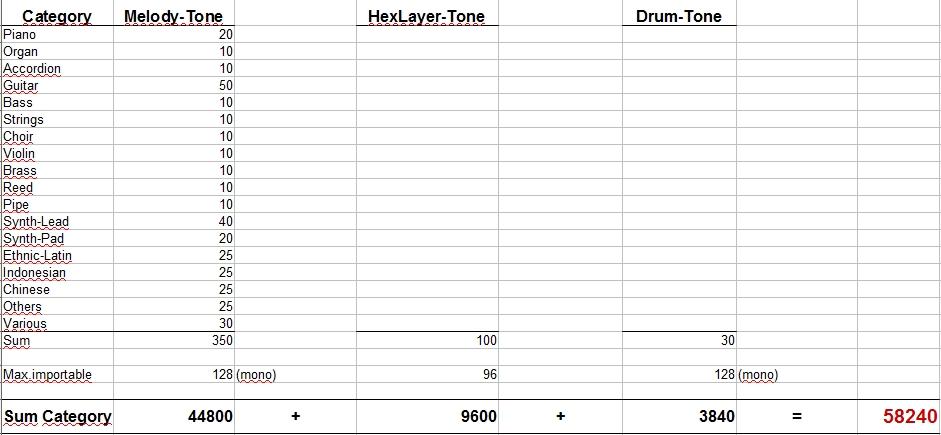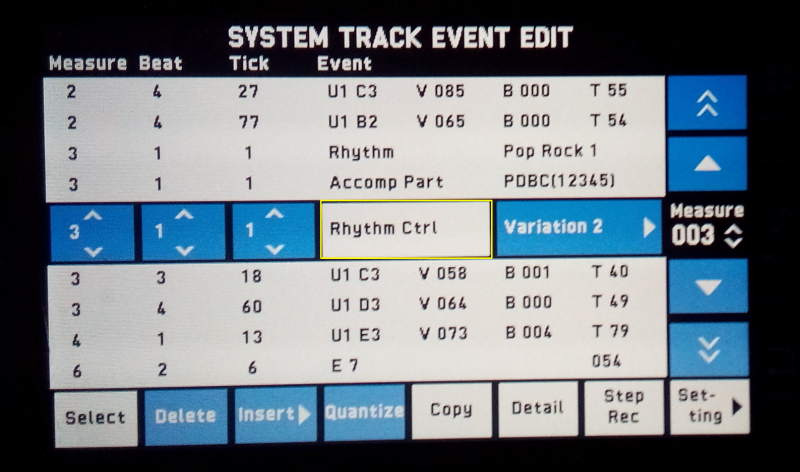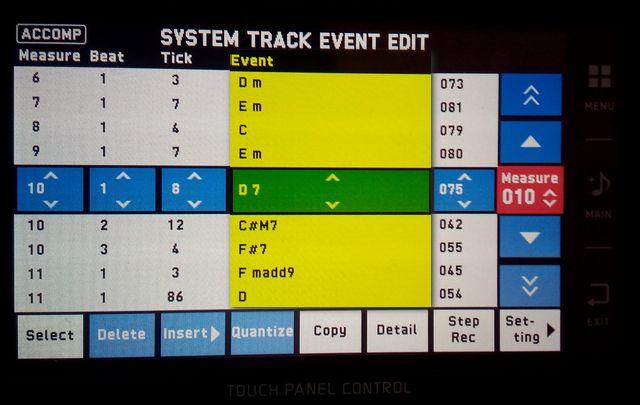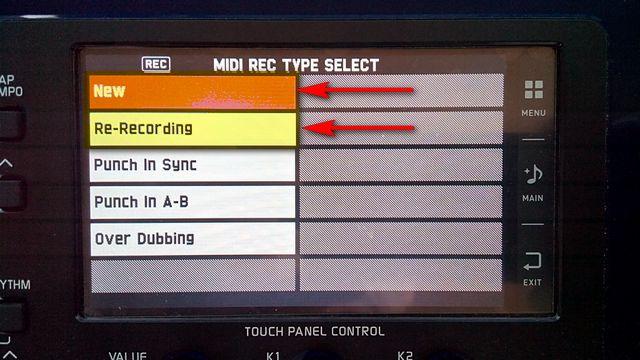
Popsel
Members-
Posts
49 -
Joined
-
Last visited
Content Type
Profiles
Forums
Downloads
Everything posted by Popsel
-
How many samples does the MZ-X support?
Popsel replied to Silvano Silva's topic in MZ-X500 / MZ-X300
Hi, The problem is that Casio uses a proprietary sample format for the MZ-X models. I contacted Chicken Systems last year and asked if the company would be willing to support the MZ-X series. I provided all the information available. The programmer later informed me that it is a proprietary format that apparently is also encrypted. After a few weeks I asked again. But it doesn't look as if anything can be expected from this side. Casio was unwilling to cooperate, he said. So the only way would be to try to find out something via "reverese engineering". But that would be a very tedious and time-consuming way with an uncertain result. Since then I have also researched myself. If there is a solution, then it is in any case a very time-consuming one and not a project that you program on a weekend. Lets see how it goes on... -
How many samples does the MZ-X support?
Popsel replied to Silvano Silva's topic in MZ-X500 / MZ-X300
e.g. the maximum number of samples supported by the firmware V1.60 -
How many samples does the MZ-X support?
Popsel replied to Silvano Silva's topic in MZ-X500 / MZ-X300
Hi Silvano, it seems like we have to find out for ourselves, like so many things about the MZ-X. The MZ-X has potential, but unfortunately insufficient documentation. For this reason, I don't think the MZ-X has had as much success as Casio would have liked. I bought my MZ-X300 & 500 about 1.5 years ago at a bargain sale price. Unfortunately I noticed very quickly that in my opinion the instruction manual does not explain the possibilities of the instrument sufficiently. I had to find out many things by experimenting myself. In order not to forget the knowledge again, I went to the trouble and wrote several additional manuals. So I can read if I forget. I was looking for a sampler with keyboard that would allow samples to be played on the keyboard. The MZ-X offers these possibilities and many more. However, I don't find working with the Sample Manager innovative. This was probably written by programmers who do not work with the MZ-X and samples themselves. There is a lot to improve. I don't expect any more updates from Casio because it seems to be uneconomical. But I see this from a different perspective. As a user, I would like to have better software that makes work easier. I'm looking for a solution ... -
How many samples does the MZ-X support?
Popsel replied to Silvano Silva's topic in MZ-X500 / MZ-X300
Hello, this information has been known for years, but does not answer my question. I have experience with the Tyros4 and built-in 1GB memory expansion especially for samples. In my experience the limit of the maximum number of samples supported by the instrument firmware is reached faster than the 1GB sample flash memory. This has the effect that only about half of 1GB of memory can be used (depending on the length of the samples used). I think it could be similar with CASIO MZ-X. It is clear that an indication of the maximum number of samples that can be used by the system interacts with the storage requirements of the samples. Nevertheless, there is a maximum number of usable samples from the operating system (firmware V1.60). If there is no other way, you have to research it yourself. In preparation, you had to delete all existing user data in order to have the maximum available system storage space available. You could load a tone with 100 extremely short samples from the USB stick again and again until an error message / warning is displayed. The number of successful imports multiplied by 100 then gives an order of magnitude, the max. importable samples. -
Hi, Too bad. As a workaround, I would then work on parts that should swing, e.g. HiHat, just record a measure or two and then quantize. Then move every 2nd note in the event editor in one direction by a certain amount. This is possible by increasing the ticks of every 2nd note position by a factor. Now you can play the result. If it meets expectations, the processed source area (1 or 2 bars) can be copied as often as required until the desired total length is reached.
-
How many samples does the MZ-X support?
Popsel replied to Silvano Silva's topic in MZ-X500 / MZ-X300
Hi! First of all, I would like to point out that we are dealing with two types of memory. There is the flash memory for recording the sample data (for the MZ-X500 256MB) and the sample memory (a kind of system table) for organization, which is the subject here. The number in the "table" is limited. From the memory allocation, depending on which memory type is first full (data sample flash memory 256MB) or the memory in the "system table", the result in reality is max. importable number of samples. I tried to calculate the total theoretical number of importable samples. However, the result is not plausible. The result, 58240 is unrealistic compared to much more expensive keyboards, such as Tyros4 (max. 9999) If someone knows better, has experience with it, please reply to this topic. Regards Popsel -
How many samples does the MZ-X support?
Popsel replied to Silvano Silva's topic in MZ-X500 / MZ-X300
Hi Brad thanks for the hint, but you misunderstood me. I am asking for the maximum number of samples that the MZ-X operating system V1.60 can handle. I am already familiar with the limitation of samples per TONE. The maximum number of samples that can be reached by the CASIO MZ-X firmware V1.60 should be in the order of several thousand samples. -
Hi, does anyone have any idea how to add swing after a quantized MIDI recording at the MZ-X500 ? Swing means to move every second MIDI note by a defined value (usually in %). It would be too tedious to make all adjustments manually for each note in the event editor. Regards Popsel
-
How many samples does the MZ-X support?
Popsel replied to Silvano Silva's topic in MZ-X500 / MZ-X300
Hi, There is 256MB MZ-X500 (128MB MZ-X300) flash memory available for storing samples. You can see how much flash memory is free on the display. With keyboards, however, a distinction is always made between the memory size for samples and the maximum number of samples supported by the operating system (V1.60). It can happen, if you use a lot of short samples, that flash memory is still available for samples, but the number of max. usable samples has already been reached. Then no new samples can be added. Is there any new knowledge or information from Casio about the maximum number of samples that firmware V1.60 supports? Here' a an Example of a Tyros Keyboard: Name: Tyros4 Firmware Upgrade Ver 1.10 Changes: 1) The upper limit of the following Custom Voice-related parameters has been increased. -VOICE RAM: from 6,144 KB to 8,960 KB -WAVE COUNT: from 8,192 to 9,999 -WAVEFORM COUNT: from 1,280 to 2,560 This means you can have a maximum of 9,999 Samples this firmware can handle. I ask because I have an idea to save flash sample space. However, this would only help if the maximum number of manageable samples is high. -
Hi, the following information is a snippet of my own manuals written for my MZ-X. The information contained therein may make the MZ-X unusable if used incorrectly! The findings are from our own experiments. The information is still incomplete. It may be that there are other features that I have not discovered yet. But I did not want to extend the experiments to the last detail to avoid unnecessary risks. My intention was to recalibrate my touch screen, which I did. The notes are in German, but with pictures. Maybe there is a German colleague who translates everything in English? If not, the Google Translator can also be used. It is not much text. Finally, the warning: This is only for people who know what they are doing. If you do not want to take any risks then give your instrument in case of problems rather in a workshop. Hallo, die folgenden Informationen sind ein Ausschnitt aus meinen eigenen Handbüchern, die ich für meine MZ-X geschrieben habe. Die darin enthaltenen Informationen können bei falscher Anwendung das MZ-X unbenutzbar machen! Die Erkenntnisse stammen aus eigenen Versuchen. Die Angaben sind noch unvollständig. Es kann sein, dass es weitere Funktionen gibt, die ich noch nicht entdeckt habe. Ich wollte die Experimente aber nicht bis ins letzte Detail ausweiten, um unnötige Risiken zu vermeiden. Meine Absicht war es mein Touch-Display neu zu kalibrieren, was mir auch gelang. Die Hinweise sind auf deutsch, aber mit Bildern. Vielleicht findet sich ein deutscher Kollege, der alles auf Englisch übersetzt? Wenn nicht kann auch der Google Translator benutzt werden. Es ist nicht viel Text. Zum Schluss noch einmal die Warnung: Das ist nur für Leute, die wissen was sie tun. Wenn man kein Risiko eingehen möchte dann gebt euer Instrument bei Problemen lieber in eine Fachwerkstatt. MZ-X Service Mode German.PDF
-
Hello, I would like to report the results. Meanwhile, I got the MZ-X500 back and it works as it should. At the end I contacted the dealer again and he informed me that CASIO did not provide him with the service manual either. Instead, CASIO has made a remote maintenance on the phone with him. CASIO told him in which order he should press certain buttons. Great, they could have done the same with me right away, saving me time and trouble. I did not have to pay any shipping costs, which had to be paid by the dealer because of the EU law "Gewährleistung". The dealer is really in order and has supported me as far as he could. But I was still not satisfied because I myself would like to do maintenance that I can do myself. Therefore, I have further researched and can now calibrate my MZ-X display myself. The MX-Z display is a resistive touch display. Most modern touch displays work on the capacitive principle. WIKIPEDIA can explain the difference. Resistive touch pads only support single touch and are relatively easy to query. Two electrically conductive foils are placed over the display with a small gap. The coating of the films has an electrical resistance which is dependent on the position. In fact, there are two resistors, one for the X and one for the Y position. When touching the display, the resistances decrease depending on the touch position on the display. These analog resistance values are then converted by an analog-to-digital converter into digital values. But still lacking the reference to the display content shown. For the operation to work, the firmware must know which resistance values correspond to which particular display position. Then constants can be determined by the calibration, which allow the firmware to match the controls shown on the display with the values measured by the analog-to-digital converter. During calibration, four corner points are touched one after another with a pointy pen for touch displays (similar to a ballpoint pen). The constants are determined and must be saved at the end. These values allow the firmware to link the controls shown on the display and the resistive touch readings of the Analog to Digital Converter. Only then does the touch display operation work as it should. What is the problem? The analog part for detecting the resistance values. It may happen that the analog resistance values are drifting due to component aging or environmental conditions. The early analogue Moog synthesizers often had to be tuned to hear the tones at the desired pitch. This does not seem that common with Resitive Touch Displays, but it does happen. Especially with increasing age, an offset of the display and touch display reaction can occur. I bought my MZ-X late at the warehouse clearance sale. At this time, the devices had been in the warehouse for several years and the original calibration was several years ago. So it is not surprising that such problems occur with increasing age. The more annoying is the fact that CASIO does not want to give out the information needed for calibration. I also want to be able to use my MZ-X in a few years and I'm persistent enough to make sure of that. After hours of searching I finally found the key combination to call the service mode. How the calibration worked then also cost time, but that's my value. I own 3x MZ-X500 and 1x MZ-X300 and have recalibrated the display of the MZ-X300 and 500. You can make the instrument unusable in service mode if you are unfamiliar with it. There is always a risk of unintentionally changing something. In service mode, the buttons have different functions than normal. I do not know if I should provide the information here. I do not want to be responsible if users make their instrument unusable due to wrong settings. So what do you think about it?
-
Hello, I tried it on the MZ-X300. Inserting a "Rhythm Ctrl" event in the system track at any bar position starts Auto Accompaniment. Greetings Popsel
-
Hello, In the meantime, I've spent several hours figuring out the secret key combination to enter Service Mode. Unfortunately without success. I'm still very interested in it. It is always an advantage if you can test something yourself. The dealer has also tried to get the service manual. In the end, he has achieved nothing. He really tried hard. He also sent me a return sticker directly. Now I have to send the MZ-X500 back to the dealer and he will send it to CASIO. Why easy if complicated is another option? Regards Popsel
-
Hallo, ich bin auch aus Deutschland. Leider hat es CASIO nicht geschafft die tollen MZ-X Features zu kommunizieren. Dazu kam, dass der Sample-Manger viel zu spät ausgeliefert wurde. Alle Tests vergleichen das MZ-X mit den anderen Marken als Arranger. Klar, in diesem Punkt hat das CASIO nicht viel zu bieten. Die Preset- Soundqualität hinkt der anderer Hersteller hinterher. Die Rhythms (Styles) sind lieblos programmiert. Vergleicht man also nur diese Punkte, dann kann das MZ-X nur verlieren. Möchte man sich aber kreativ betätigen, dann stehen extrem viele und flexible Möglichkeiten offen. Leider fehlt eine brauchbare Dokumentation, mit Beispielen, was man alles machen kann. Ich sitze seit Wochen daran, mir Informationen zusammenzutragen und mir eine eigene, Anleitung mit den für mich wichtigen Funktionen, zu erstellen. Obwohl ich noch nicht viel damit gemacht habe, haben meine ersten Versuche in kurzer Zeit viel interessantere Sounds als die Preset Sounds hervorgebracht. Besonders die Hex-Layer Presets zeigen kaum, was damit erreichbar ist. Casio muss Geld verdienen. Mit dem MZ-X haben sie Verluste gemacht. Zuletzt wurden die Instrumente zum Taschengeldpreis abverkauft, nachdem sie zwei Jahre im Lager gelegen haben. Ich glaube nicht, dass CASIO noch einmal ein Firmware-Update für das MZ-X produziert. Auf der anderen Seite konnte man ein Instrument der 1000 EUR Klasse für um die 440 EUR bekommen. Der Preis, den der Kunde zahlt ist der Zeitaufwand, die nötigen Informationen zusammenzutragen und eigene Experimente zu machen wenn man das Instrument vollumfänglich nutzen möchte. Insgesamt bin ich mit den geboteten Möglichkeiten sehr zufrieden. Auch die Firmware läuft bisher stabil. Ich hatte noch keine Probleme. Google Translation: Hello, I am also from Germany. Unfortunately CASIO did not manage to communicate the great MZ-X features. In addition, the sample-Manger was delivered far too late. All tests compare the MZ-X with the other brands as Arranger. Sure, the CASIO does not have much to offer on this point. The preset sound quality lags behind that of other manufacturers. The Rhythms (Styles) are carelessly programmed. If you compare only these points, then the MZ-X can only lose. But if you want to be creative, then there are many and flexible options open to you. Unfortunately, a useful documentation is missing, with examples of what you can do everything. I have been sitting for weeks gathering information and creating my own instructions with the functions that are important to me. Although I have not done much with it yet, my first attempts in a short time have produced much more interesting sounds than the preset sounds. Especially the hex-layer presets hardly show what can be achieved with it. Casio has to make money. They have made losses with the MZ-X. Most recently, the instruments were sold off at the pocket money price after two years in the warehouse. I do not think that CASIO once again produces a firmware update for the MZ-X. On the other hand, you could get an instrument of the 1000 EUR class for around 440 EUR. The price that the customer pays is the time spent gathering the necessary information and doing your own experiments if you want to make full use of the instrument. Overall, I am very satisfied with the opportunities offered. The firmware is running stable. I did not have any problems yet.
-
Hi, thank you Brad and Jockeyman123. I think it's a shame that Casio behaves like that. I contacted CASIO Germany one more time and they at least appealed to me to send me the information for calibrating the touch pad. They offered to "fix" the MZ-X. For this I have to send in the instrument. That's exactly what I wanted to avoid. Because CASIO does not meet me, I contacted the dealer and described the problem to him. For economic and logistical reasons, it would be better if I could solve the problem myself. The dealer has written "He will check what he can do". If I do not receive any information from the dealer to calibrate the touch pad, then he must bear all costs for troubleshooting under German law. The keyboard was already delivered with the problem. Therefore, I believe that I still have the best chances of the dealer to get the information needed. Casio does not supply spare parts to customers on the German website. That's why I bought a MZ-X300 a few months ago. If necessary, I can use this as a spare parts dispenser. In summary, I do not think that's customer friendly. It is clear that CASIO can not offer the same hardware quality for the relatively low sales price as other manufacturers whose instruments cost several times. I'm talking about CASIO's top product, not a cheap keyboard, which you simply throw away in the event of a defect. I hope Casio reads this post and thinks about his attitude in the future. Regards Popsel
-
Hello, I contacted CASIO Germany and asked to provide the MX-X Service manual. They have replied that they do not provide the service manual. Casio Germany did not say there is no service manual. As an electronics engineer, I have the ability to maintain my instrument for home use. As far as I know, the MZ-X is no longer produced. My wife and I now have three MZ-X500 and one MZ-X300 and want to use the instruments even longer. After receiving no support here in Germany, I ask the members of this forum for help. In a country as big as the US, there must be someone who can get me an MZ-X service manual. Regards Popsel
-
How many samples does the MZ-X support?
Popsel replied to Silvano Silva's topic in MZ-X500 / MZ-X300
Hello, I bought the MZ-X mainly because of the sampler. I would also be very interested in how CASIO implements the samples prepared with the sample manager in the MZ-X. Yamaha MOX-F and Tyros 4 have a maximum number of samples that the system can manage. The memory is there separated into the FLASH ROM for the sample data (separate module 512MB - 2GB) and the management data, which are housed in the internal system flash memory. So it may happen that the limit of the maximum manageable samples has already been reached, although there is still enough free space in the sample flash module. But that's the case with Yamaha. Unfortunately, I do not know how Casio handles it. It's definitely an interesting topic. Could it be that the message "DATA FULL" does not refer to samples at all? The message may refer to a different type of data. -
Hello, I am an experienced electronics engineer and have a problem with the MZ-X500 (firmware 1.60). A few weeks ago bought a second MZ-X500 (B-Stock). At the upper edge of the display (about 15mm), the touch pad does not react as it should. I always have to touch something below the displayed item to activate the desired function. I am looking for a service manual for MZ-X 300/500. How can I activate the service mode or diagnostic mode of the MZ-X? There should be a way to calibrate the touch pad. I have already tried a factory reset, which did not bring any improvement. Regards Popsel
-
Hi, you get me wrong. The Music Preset is syncronized with the accompaniment. This works, but I have to setup my chords list so music preset can drive the accompaniment. I would like to live record only the accompaniment, but this time live. MZ-X should snap wiggely chords to the nearest beats or measures. So I end with a perfect timing for the accompaniment to build up a song. The Casio quantize functions ignore CHORD-EVENTS. Quantizing a system track affects only normal midi notes (Upper / Lower) no Chord-Events. My way of creating a song is unusual for the standard live keyboard player. It seems I have to use the Music Preset or the Pads Chord Sequence feature. I am new to MZ-X and it is well underdocumented. So I thought I miss an option to snap or quantize live recorded chords. Thank you Regards Popsel
-
Hi, if you take a look at the lower half of my screenshot you may see this is not true. The chord-start can be set at any position. I am lookig for a way to quantise the chord start point to eg. sequencer Beats or Measures. If there is an option to snap Chord Events while recording to Measures or Beats this would help, too. I am not a keyboarder, so I would like first to record the chords in perfect timing and in the next step add more tracks. Regards Popsel
-
Hello, Casio distinguishes between note and chord events, which control the automatic accompaniment. Chords can be pre-programmed in a list via "Music Preset". The pads also have a similar possibility. For chords that were recorded live via the keyboard and recorded with the MIDI recorder I would like to correct the timing. My attempts to quantize chord events after MIDI recording were unsuccessful. The Casio "Quantize" function apparently handles only MIDI note events, not chord events. An alternative would be the ability to quantize chords while recording. I could not find a function to catch chord events (quantize chords while recording). Are there any other ways to quantize chords I did not find? Regards Popsel
-
Midi Recorder: MIDI REC TYPE SELECT differences?
Popsel replied to Popsel's topic in MZ-X500 / MZ-X300
Hi, thank you. I found an answer from Brad: "Re-Record" keeps the header (Setup Data) while "New" rewrites the header Mixer Data. Regards Popsel -
Hello, I am currently learning the recording options of the MZ-X Midi recorder. My MX-X500 firmware version is 1.60 For the overdub options there is the point "New" and "Re-Recording". I do not understand what the difference between the two options is. In the instruction manual "Re-Recording" is not mentioned. Who can explain the difference? Regards Popsel






